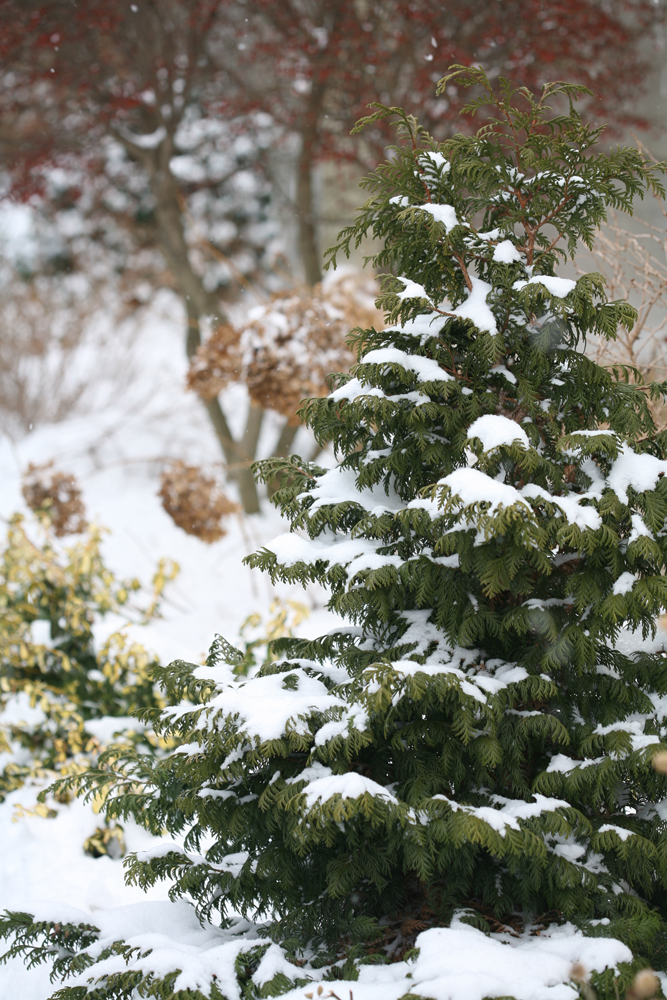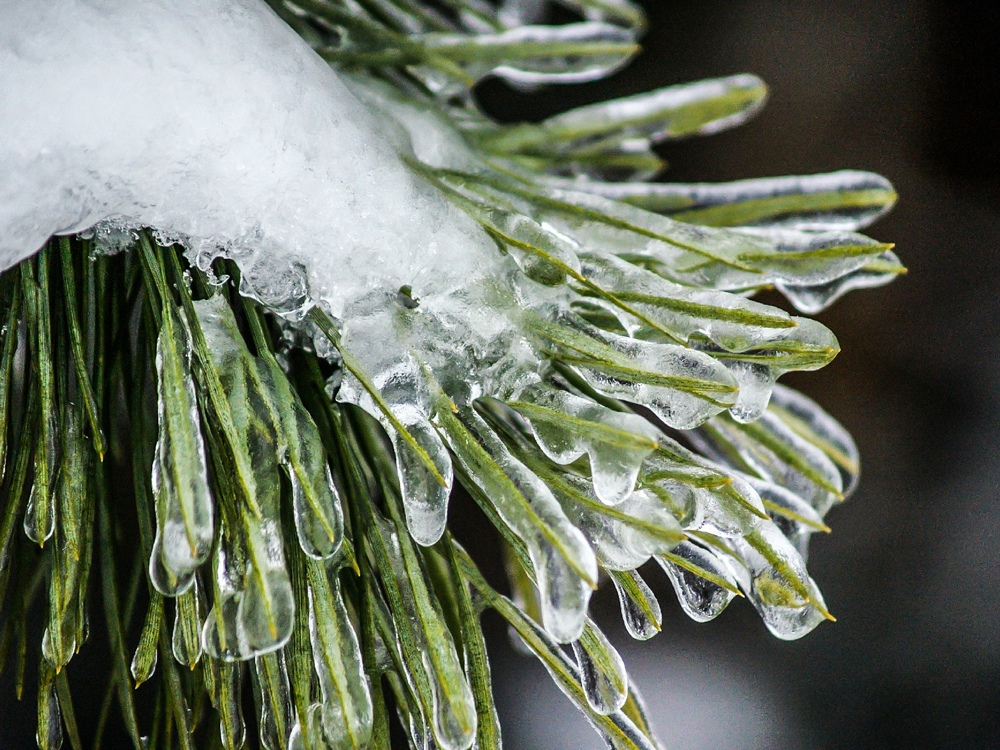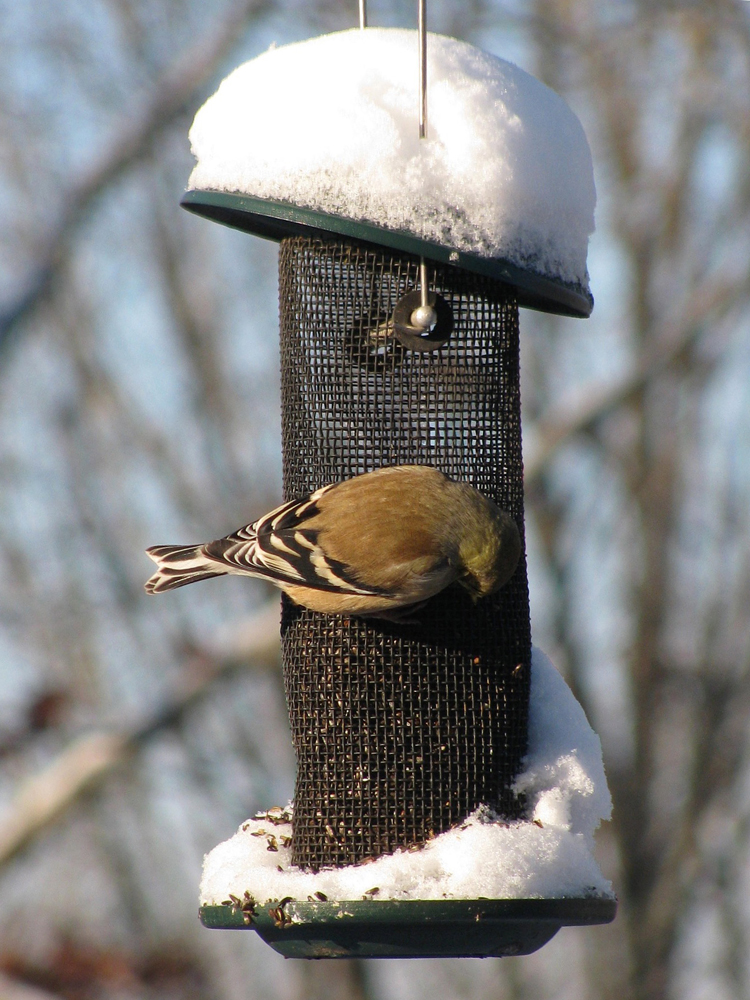So what if there is a foot of snow on the ground! Some of us just need to garden anyway. Now might not be the best time to be out pruning and planting in most climates, but there are still some important gardening activities we can be working on while we wait out Old Man Winter. Here are eight winter gardening tasks and ideas for scratching that gardening itch this winter.

1. Evaluate your winter garden for structure and privacy.
Standing in your cozy warm house this winter, take a look outside to see if there are any eyesores that have become more obvious now that the trees are bare. Is a neighbor’s bright red shed in prime view when you’re standing at your kitchen sink? Is there a straight view out to the street from your bedroom window? Are there places that just look blah now that your gardens are all fast asleep?
While the ground is still soft enough, head out and put stakes in the ground in the spots where you need to add evergreens or something with more winter structure. You’ll be glad you did when it’s time to plant in spring, and next year’s winter view is guaranteed to be improved.
2. Repurpose your Christmas tree as winter mulch.
Why add your Christmas tree to the local landfill when you can repurpose it in your garden? Simply cut the branches off the trunk and lay them down in your garden beds. I like to lay mine over evergreen perennials like coral bells or anything that’s a little tender in my zone to give them a little added protection. By spring, the needles have usually dried up and fallen off—one more way I enrich my soil with the natural resources Mother Nature provides.
3. Resist the urge to remove snow and ice from your plants.

This is a really tough one, I know. I have the same urge to “rescue” my plants from the weight of the heavy snows that fall in my region, but I know better. More of than not, greater damage is done by trying to remove the snow and ice than by letting nature take its course. There isn’t much that can be done to help your trees after an ice storm. The branches become extremely brittle under all that weight, making it dangerous to be near them. The best we can do is pray for sunshine to melt the ice.
4. Keep an eye on potted bulbs and containerized plants.
If you are overwintering plants in containers or have any potted bulbs you’re storing for winter, it’s important to keep an eye on them for three reasons.
#1 – Rodents. If you were a mouse or vole, you’d love to spend the winter in a relatively warm garage or shed in a comfy pot of soil, too. The trouble comes when they eat the roots or crown of the plant, or when they disturb the soil so much that cold air pockets settle in around the roots. Bait for or trap rodents where you are overwintering your plants.
#2 – Desiccation. Though your plants won’t need much water while they are dormant, you don’t want them to completely dry out. What works for me is adding a layer of snow on top of my pots every 3-4 weeks in winter and letting it melt slowly over time. If you live someplace where it doesn’t snow much in winter (lucky you!), use a watering can instead.
#3 – Dormancy. Your goal should be to keep the plants dormant all winter once they drop their leaves. You want them to sleep soundly until spring arrives. If there is a warm spell in the middle of winter and your plants start to leaf out again, they will likely be damaged when the cold winter temperatures return.
5. Provide food and water for birds.

Food and water for birds become scarce once plants go dormant and water sources freeze over. Birds are our friends in the garden; we enjoy their presence, but they also play a key role in controlling insect populations. Encourage them to stick around all year by putting up a bird feeder and keeping it filled all winter long.
The best kinds of bird seed to provide in winter are those that are high in fat or oil content like sunflower seeds, peanuts or suet cakes. Choose a feeder with a shield over the top to keep snow and ice from settling in.
Heated birdbaths are much appreciated by birds once their usual water sources freeze over. You could purchase a heating coil to use in your existing birdbath or buy one that has a heating element incorporated into its design. Both solar and corded options are available.
6. Sort through your plant labels to see what’s worth repeating.
When I pot up my patio containers every year, I always stick the plant labels in the back of the pot for reference. When it’s time to empty them in late fall, I keep the labels of the plants I liked and toss those I wouldn’t buy again. It’s a simple way to remind myself of what’s worked well in the past and what I’ll look for again next spring. Winter is the perfect season to sort through your old plant labels and start planning for the new season.
7. Start planning and interviewing landscape professionals.

If you completed task #1 and found a few spots where you’d like to add more privacy or structure, now is the time to start sketching those ideas out on paper. Maybe you’ve decided your foundation plantings need a little more pizzazz or maybe this is the year you are finally going to build raised beds to grow your own tomatoes in.
Winter is the perfect time of year to dream, scheme and plan for spring. It’s the thoughts of plump peony buds and fragrant lilacs that get us gardeners through the dreariest months. So do your research, take lots of notes, start a Pinterest board and get ready. Spring will be here before you know it.
It seems counterintuitive, but winter is also a great time to start talking with a landscape firm that can help you with any large projects. Have a plan in mind when you meet so you can discuss costs and timelines together. If you get on their list now, they should be able to start the work as soon as the weather breaks in spring.
8. Take stock of your tools.
Now that your garden tools are all cleaned and stored away for winter, make a list of which old, worn out tools need to be replaced or which new tools would make gardening easier for you. When someone asks you for gift suggestions this holiday, you’ll be ready with your list. Be sure to pass along any useful tools that are no longer needed to someone you know who could put them to good use or is just learning how to garden.
Where will you begin? I think I’ll start by adding a heated birdbath to my Christmas list!

3 thoughts on “8 Winter Gardening Tasks for People Who Just Can’t Stop Gardening”
These 8 winter help notes were perfect! I am in a garden club in St.. Louis , MO, and would love to share these tips with everyone.
Is there a way I can get a copy of what you just posted.?
Thanks… Karin❄️🌱
Hi Karin- You can certainly share this link with everyone.
Heated birdbath is most important in our garden.
The rest of the list of winter chores will help many new gardeners. Good advice👍